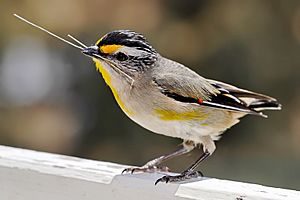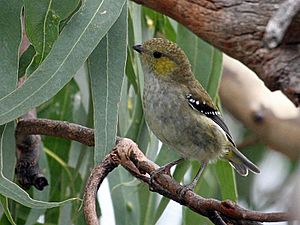Pardalote facts for kids
Quick facts for kids Pardalotes |
|
|---|---|
 |
|
| Pardalotus striatus ornatus with nesting material | |
| Scientific classification |
|
| Kingdom: | Animalia |
| Phylum: | Chordata |
| Class: | Aves |
| Order: | Passeriformes |
| Superfamily: | Meliphagoidea |
| Family: | Pardalotidae Strickland, 1842 |
| Genus: | Pardalotus Vieillot, 1816 |
| Species | |
Pardalotes are a group of very small, brightly colored birds. They are found only in Australia. These birds have short tails, strong legs, and small, blunt beaks.
There are four different kinds, or species, of pardalotes. They all belong to one main group, called a genus, named Pardalotus. The name "pardalote" comes from a Greek word meaning "spotted," which fits some of these birds well!
Pardalotes spend most of their time high up in the leaves of trees. They eat insects and spiders. Their favorite food is something called "lerps." Lerps are tiny, sugary coverings made by sap-sucking insects. Pardalotes help control these insects in Australia's eucalyptus forests.
These birds usually live in pairs or small family groups. Sometimes, after they have raised their young, they might gather in larger flocks.
Pardalotes build their nests in deep tunnels. They dig these tunnels into banks of earth. The entrance looks like a mouse-hole, but the tunnel can be very long, sometimes over a meter deep! Some pardalotes also nest in hollows found in trees. Both parents work together to build the nest, sit on the eggs, and feed their chicks.
Contents
What are Pardalotes?
Pardalotes are small, compact birds. They are usually between 8.5 and 12 centimeters long. That's about the size of your hand! Some pardalotes are bigger in colder southern areas and smaller in warmer northern areas.
Male and female pardalotes are usually the same size. However, their feathers can look a little different between males and females in some species. They have short, square-tipped tails. Their wings are short and rounded, but they are longer in species that travel more. Pardalotes have strong, short beaks.
Where Do Pardalotes Live?
Pardalotes are endemic to Australia. This means they are found nowhere else in the world! Each type of pardalote lives in different parts of Australia.
The forty-spotted pardalote has the smallest home range. It lives only in Tasmania. The striated pardalote is the most widespread. You can find it almost everywhere in Australia, except for some very dry desert areas. The red-browed pardalote lives in the north and west of Australia. The spotted pardalote lives closer to the coast in southern and eastern Australia.
Pardalotes love eucalyptus forests. They can live in tall forests where the trees are over 30 meters high. They also live in shorter woodlands where the trees are only about 3 meters tall. While they might visit other types of trees, eucalyptus forests are their main home.
What Do Pardalotes Eat?
Pardalotes mostly eat insects. They sometimes eat plant parts, like seeds. There was even one time a striated pardalote was seen eating a small lizard!
During the breeding season, they usually feed alone or in pairs. In winter, they might join groups of different bird species to find food. They mostly look for food on eucalyptus trees.
Pardalotes find insects by picking them off leaves. They don't usually catch insects while flying. Their main food is "lerps." These are sugary coverings made by tiny insects called psyllids. Pardalotes are very good at finding and eating these lerps. Larger birds called honeyeaters also like lerps and sometimes try to chase pardalotes away. Studies show that pardalotes spend about 5% of their day avoiding honeyeater attacks!
Pardalote Movements
Pardalotes often move around during winter. They might fly north or move to lower areas. For example, striated pardalotes fly from Tasmania across Bass Strait to the Australian mainland for winter. Spotted and striated pardalotes also move from high-altitude forests to drier inland plains in southeastern Australia.
Sometimes, pardalotes move to follow where their favorite food, psyllids, are plentiful. Some groups of pardalotes stay in one place all year. Forty-spotted pardalotes probably stay in eastern Tasmania and its nearby islands. We don't know as much about how red-browed pardalotes move.
Pardalote Conservation
Most pardalote species, like the striated, spotted, and red-browed pardalotes, are common. However, their numbers are going down. This is mainly because they are losing their homes. Clearing land and cutting down trees in eucalyptus forests means less food and fewer places for them to nest. It also breaks up the forest areas they need to move around.
The forty-spotted pardalote is listed as an Endangered species. This means it is at high risk of disappearing forever. It lives in a very small area, and there are not many of them left. Also, their population is split into small groups.
Threats to the forty-spotted pardalote include:
- Losing their habitat.
- Competition with other birds, especially the noisy miner.
- Parasites: A type of fly can lay eggs in their nests. These flies cause many young forty-spotted pardalotes to die.
The effects of climate change are not fully known yet. However, it is thought that the striated pardalote might lose some of its living areas in Western Australia due to climate change.
Images for kids




